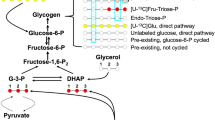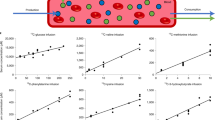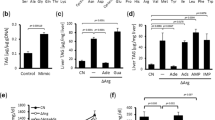Abstract
IT is known that citrate, as well as being an intermediate of the tricarboxylic acid cycle, may also be involved in metabolic regulation because it increases the substrate affinity of acetyl-CoA carboxylase1 and also acts as a direct inhibitor of phosphofructokinase2,3. In view of the contradictory reports concerning the concentrations of rat liver citrate in different physiological conditions it is of interest to present data on the citrate concentrations of different rat tissues during starvation and refeeding with carbohydrate. The rats used were normal adult females weighing 200–300 g which had been raised on a standard diet (Instytut Leków, Warszawa). During the refeeding period animals were maintained on a high-glucose diet4. Rats were always decapitated at 12 o'clock. Pieces of liver and whole kidneys, heart and brain were rapidly removed, in this order, and placed in a mixture of carbon dioxide and ethanol. The frozen tissue was weighed and ground in a mortar, which was precooled, with 5 per cent trichloroacetic acid, and made up to volume for citrate analysis. Citrate was estimated according to McArdle5. Before determining the concentration of citric acid, samples were heated in a boiling water bath for 10 min.
This is a preview of subscription content, access via your institution
Access options
Subscribe to this journal
Receive 51 print issues and online access
$199.00 per year
only $3.90 per issue
Buy this article
- Purchase on Springer Link
- Instant access to full article PDF
Prices may be subject to local taxes which are calculated during checkout
Similar content being viewed by others
References
Martin, D. B., and Vagelos, P. R., Biochem. Biophys. Res. Commun., 7, 101 (1962).
Passonneau, J. V., and Lowry, O. H., Biochem. Biophys. Res. Commun., 13, 372 (1963).
Garland, P. B., Randle, P. J., and Newsholme, E. A., Nature, 200, 169 (1963).
Blumenthal, M. D., Abraham, S., and Chaikoff, I. L., Arch. Biochem. Biophys., 104, 215 (1964).
McArdle, B. A., Biochem. J., 60, 647 (1955).
Parmeggiani, A., and Bowman, R. M., Biochem. Biophys. Res. Commun., 12, 268 (1963).
Tubbs, P. K., and Garland, P. B., Biochem. J., 93, 550 (1964).
Lynen, F., Matsuhashi, M., Numa, S., and Schweizer, E., in The Control of Lipid Metabolism (edit. by Grant, J. K.), 43 (Academic Press, London, 1963).
Frohman, Ch. E., Orten, J. M., and Smith, A. M., J. Biol. Chem., 193, 803 (1951).
Srere, P. A., Nature, 205, 766 (1965).
Kornacker, M. S., and Lowenstein, J. M., Biochem. J., 94, 209 (1965).
Srere, P. A., J. Biol. Chem., 234, 2544 (1959).
Author information
Authors and Affiliations
Rights and permissions
About this article
Cite this article
ANGIELSKI, S., SZUTOWICZ, A. Tissue Content of Citrate and Citrate-cleavage Enzyme Activity during Starvation and Refeeding. Nature 213, 1252–1253 (1967). https://doi.org/10.1038/2131252a0
Issue Date:
DOI: https://doi.org/10.1038/2131252a0
Comments
By submitting a comment you agree to abide by our Terms and Community Guidelines. If you find something abusive or that does not comply with our terms or guidelines please flag it as inappropriate.



